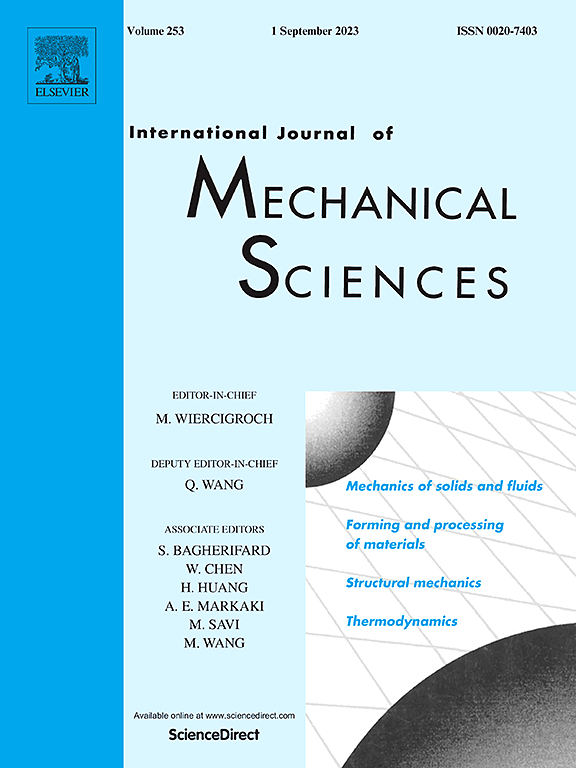折纸型软连续体机器人的叶状和Kresling图案耦合
IF 7.1
1区 工程技术
Q1 ENGINEERING, MECHANICAL
International Journal of Mechanical Sciences
Pub Date : 2025-07-18
DOI:10.1016/j.ijmecsci.2025.110620
引用次数: 0
摘要
折纸和受折纸启发的结构在工程中得到了广泛的应用,折纸图案以及它们独特的机械性能也因此变得越来越多样化。在这里,我们通过将刚性叶状折纸作为非刚性Kresling折纸的构建块,创建了一种源自Kresling折纸的新型折痕图案。由此产生的耦合Leaf-like和Kresling折纸继承了可折叠性,多稳定性和可调刚度,同时也表现出相反的手性和多自由度(dof)。与传统的Kresling折纸相比,由于这些机械性能和增强的灵活性,耦合折纸非常适合于软连续体机器人的应用。为了展示其应用潜力,以耦合折纸为主体,构建了两种肌腱驱动的柔性连续体机器人——操作机器人和移动机器人。实验验证了机器人执行各种任务和运动的能力,包括定位、爬行、转弯和攀爬。该研究有助于推进折纸设计,拓宽其在折纸机器人系统开发中的适用性。本文章由计算机程序翻译,如有差异,请以英文原文为准。
Coupled Leaf-like and Kresling Patterns for Origami-Inspired Soft Continuum Robots
Origami and origami-inspired structures are widely utilized in engineering, and origami patterns—as well as their unique mechanical properties—are growing in variety as a result. Here, we create a novel crease pattern derived from Kresling origami by incorporating the rigid Leaf-like origami as a building block within the non-rigid Kresling origami. The resulting coupled Leaf-like and Kresling origami inherits foldability, multistability, and tunable stiffness, while also exhibiting opposite chirality and multiple degrees of freedom (DOFs). Owing to these mechanical properties and its enhanced flexibility compared to the traditional Kresling origami, the coupled origami is well-suited for applications in soft continuum robotics. To demonstrate its practical potential, two types of tendon-driven soft continuum robots—a manipulative robot and a mobile robot are constructed employing the coupled origami as their main body. Experiments validate the robots’ ability to perform various tasks and motions, including positioning, crawling, turning, and climbing. This study contributes to the advancement of origami design and broadens its applicability in the development of origami-inspired robotic systems.
求助全文
通过发布文献求助,成功后即可免费获取论文全文。
去求助
来源期刊

International Journal of Mechanical Sciences
工程技术-工程:机械
CiteScore
12.80
自引率
17.80%
发文量
769
审稿时长
19 days
期刊介绍:
The International Journal of Mechanical Sciences (IJMS) serves as a global platform for the publication and dissemination of original research that contributes to a deeper scientific understanding of the fundamental disciplines within mechanical, civil, and material engineering.
The primary focus of IJMS is to showcase innovative and ground-breaking work that utilizes analytical and computational modeling techniques, such as Finite Element Method (FEM), Boundary Element Method (BEM), and mesh-free methods, among others. These modeling methods are applied to diverse fields including rigid-body mechanics (e.g., dynamics, vibration, stability), structural mechanics, metal forming, advanced materials (e.g., metals, composites, cellular, smart) behavior and applications, impact mechanics, strain localization, and other nonlinear effects (e.g., large deflections, plasticity, fracture).
Additionally, IJMS covers the realms of fluid mechanics (both external and internal flows), tribology, thermodynamics, and materials processing. These subjects collectively form the core of the journal's content.
In summary, IJMS provides a prestigious platform for researchers to present their original contributions, shedding light on analytical and computational modeling methods in various areas of mechanical engineering, as well as exploring the behavior and application of advanced materials, fluid mechanics, thermodynamics, and materials processing.
 求助内容:
求助内容: 应助结果提醒方式:
应助结果提醒方式:


